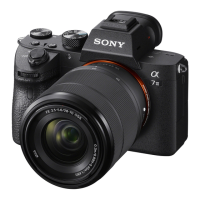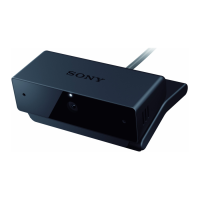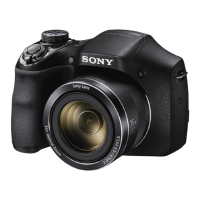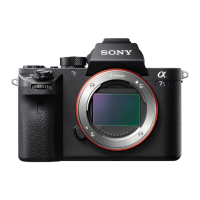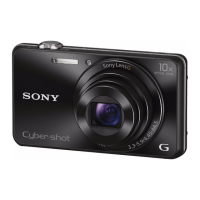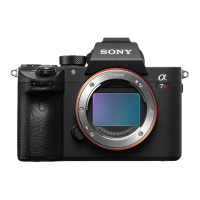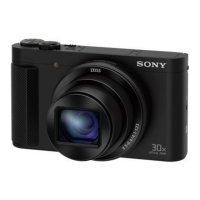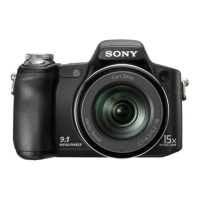Do you have a question about the Sony BURANO MPC-2610 and is the answer not in the manual?
Diagram illustrating camera components and accessories.
Detailed description of buttons and connectors on the operator switch side.
Instructions on how to use the touch screen interface and gestures.
Step-by-step guide for mounting the handle and viewfinder assembly.
Information on using battery packs and AC adapters for powering the camera.
Guide on configuring the camera's internal clock and time zone settings.
Procedures for attaching PL-mount lenses and adjusting flange focal length with shims.
Procedures for inserting, ejecting, formatting, and managing CFexpress Type B memory cards.
Instructions for inserting, removing, formatting, and using utility SD cards.
Explanation of the LCD monitor's different modes and screen layouts.
Details on information displayed on the LCD screen during shooting and standby modes.
Introduction to the Home screen for checking status and setting basic parameters.
Explanation of the different status screens (Project, Audio, Monitoring) and their functions.
Overview of the camera's full menu system and its organizational structure.
How to navigate and operate the full menu, including character entry and locking features.
Explanation of the default functions and settings available in the User menu.
Settings for controlling exposure through ISO, gain, and exposure index adjustments.
Configuration options for the ND filter and electronic shutter settings.
Settings for iris control, bokeh, and automatic exposure adjustments.
Procedures for setting white balance and configuring focus parameters.
Advanced focus settings, slow/quick motion, and LUT application options.
Settings for managing noise, correcting flicker, and enabling image stabilization.
Configuration of project base settings and recording format parameters like frequency and codec.
Setup for various recording modes including Cine EI, Simul Rec, Proxy Rec, Interval Rec, and Picture Cache.
Settings for controlling external recording and assigning functions to buttons.
Configuration of assignable dials and the multi-function dial for operational control.
Settings for scene files, base looks, and resetting paint/look configurations.
Settings related to timecode, clip naming, media updates, and formatting.
Configuration of video output formats, de-squeeze ratios, and display settings for SDI/HDMI.
Configuration of audio input sources, reference levels, wind filters, and level controls for channels.
Functions for managing clips, setting flags, locking, transferring, filtering, and customizing the view.
Settings for color bars, ND dial, recording lamps, lock switches, touch operation, zoom, and handle zoom.
Table showing which image quality settings are saved for Cine EI, Custom SDR, and Custom HDR modes.
Procedures for saving and loading user files and all configuration data to/from SD cards or cloud.
Introduction to the clips screen, displaying clip information and thumbnails.
Details on controlling clip playback using the screen interface and status indicators.
Configuration of network setup, wireless LAN connections, and AP mode settings.
Configuration for wired LAN connections, USB tethering, and file transfer settings.
Methods for connecting the camera to the internet using USB tethering, Wi-Fi, or wired LAN.
How to set up file transfer destinations and upload proxy or original clips.
Using the Creators' App for file transfer to C3 Portal cloud service.
Setting up shooting mode, system frequency, and imager scan mode for optimal shooting.
Step-by-step guide for fundamental shooting operations including recording and media handling.
Techniques for adjusting image looks using LUTs during shooting for post-production.
Customizing image looks by adjusting parameters and saving them as scene files.
How to adjust optical zoom and Clear Image Zoom using the grip or handle.
Methods for manual focus adjustment, including spot focus and push auto focus.
Configuring auto focus areas and quickly changing focus settings using assignable buttons.
Utilizing human detection and realtime tracking for automatic subject focus.
Methods for adjusting camera brightness using iris, base sensitivity, and gain controls.
How to adjust brightness using shutter speed/angle and ND filters.
Techniques for setting white balance automatically or manually for accurate color reproduction.
Enabling and configuring image stabilization for smoother footage.
Configuring audio input sources and adjusting recording levels for channels.
Guide to using the direct menu and customizing assignable buttons and dials.
Configuration of slow/quick motion and interval recording modes.
Using Interval Rec for time-lapse and Picture Cache Rec for retroactive recording.
Adjusting gamma assist, lens breathing compensation, bokeh effect, and de-squeeze display.
Procedure for recording proxy clips simultaneously with main recording.
Guidelines for connecting external monitors and recording devices via SDI and HDMI.
Methods for synchronizing video signals (genlock) and timecode between multiple units.
How to connect to a computer via USB for clip management and editing.
Important safety, care, and operational precautions for using the unit.
Table detailing output formats available via SDI and HDMI connectors.
Table showing approximate recording and playback times for various settings on CFexpress cards.
Solutions for common problems related to power supply and recording/playback.
Solutions for wireless LAN, internet connection, and ND filter malfunction problems.
Lists common error and warning messages and their causes and solutions.
Table detailing which settings are saved in 'All File' and 'Scene File' types.
Visual representation of the audio input signal flow for channels 1 and 2.
Instructions for checking lens software versions and updating the firmware.
Legal information regarding software licenses, patents, and the end-user license agreement.
Technical specifications for mass, dimensions, power, recording formats, camera sensor, and auto focus.
Detailed mechanical drawings showing external dimensions from multiple perspectives.
List of trademarks and registered trademarks associated with the product.
Diagram illustrating camera components and accessories.
Detailed description of buttons and connectors on the operator switch side.
Instructions on how to use the touch screen interface and gestures.
Step-by-step guide for mounting the handle and viewfinder assembly.
Information on using battery packs and AC adapters for powering the camera.
Guide on configuring the camera's internal clock and time zone settings.
Procedures for attaching PL-mount lenses and adjusting flange focal length with shims.
Procedures for inserting, ejecting, formatting, and managing CFexpress Type B memory cards.
Instructions for inserting, removing, formatting, and using utility SD cards.
Explanation of the LCD monitor's different modes and screen layouts.
Details on information displayed on the LCD screen during shooting and standby modes.
Introduction to the Home screen for checking status and setting basic parameters.
Explanation of the different status screens (Project, Audio, Monitoring) and their functions.
Overview of the camera's full menu system and its organizational structure.
How to navigate and operate the full menu, including character entry and locking features.
Explanation of the default functions and settings available in the User menu.
Settings for controlling exposure through ISO, gain, and exposure index adjustments.
Configuration options for the ND filter and electronic shutter settings.
Settings for iris control, bokeh, and automatic exposure adjustments.
Procedures for setting white balance and configuring focus parameters.
Advanced focus settings, slow/quick motion, and LUT application options.
Settings for managing noise, correcting flicker, and enabling image stabilization.
Configuration of project base settings and recording format parameters like frequency and codec.
Setup for various recording modes including Cine EI, Simul Rec, Proxy Rec, Interval Rec, and Picture Cache.
Settings for controlling external recording and assigning functions to buttons.
Configuration of assignable dials and the multi-function dial for operational control.
Settings for scene files, base looks, and resetting paint/look configurations.
Settings related to timecode, clip naming, media updates, and formatting.
Configuration of video output formats, de-squeeze ratios, and display settings for SDI/HDMI.
Configuration of audio input sources, reference levels, wind filters, and level controls for channels.
Functions for managing clips, setting flags, locking, transferring, filtering, and customizing the view.
Settings for color bars, ND dial, recording lamps, lock switches, touch operation, zoom, and handle zoom.
Table showing which image quality settings are saved for Cine EI, Custom SDR, and Custom HDR modes.
Procedures for saving and loading user files and all configuration data to/from SD cards or cloud.
Introduction to the clips screen, displaying clip information and thumbnails.
Details on controlling clip playback using the screen interface and status indicators.
Configuration of network setup, wireless LAN connections, and AP mode settings.
Configuration for wired LAN connections, USB tethering, and file transfer settings.
Methods for connecting the camera to the internet using USB tethering, Wi-Fi, or wired LAN.
How to set up file transfer destinations and upload proxy or original clips.
Using the Creators' App for file transfer to C3 Portal cloud service.
Setting up shooting mode, system frequency, and imager scan mode for optimal shooting.
Step-by-step guide for fundamental shooting operations including recording and media handling.
Techniques for adjusting image looks using LUTs during shooting for post-production.
Customizing image looks by adjusting parameters and saving them as scene files.
How to adjust optical zoom and Clear Image Zoom using the grip or handle.
Methods for manual focus adjustment, including spot focus and push auto focus.
Configuring auto focus areas and quickly changing focus settings using assignable buttons.
Utilizing human detection and realtime tracking for automatic subject focus.
Methods for adjusting camera brightness using iris, base sensitivity, and gain controls.
How to adjust brightness using shutter speed/angle and ND filters.
Techniques for setting white balance automatically or manually for accurate color reproduction.
Enabling and configuring image stabilization for smoother footage.
Configuring audio input sources and adjusting recording levels for channels.
Guide to using the direct menu and customizing assignable buttons and dials.
Configuration of slow/quick motion and interval recording modes.
Using Interval Rec for time-lapse and Picture Cache Rec for retroactive recording.
Adjusting gamma assist, lens breathing compensation, bokeh effect, and de-squeeze display.
Procedure for recording proxy clips simultaneously with main recording.
Guidelines for connecting external monitors and recording devices via SDI and HDMI.
Methods for synchronizing video signals (genlock) and timecode between multiple units.
How to connect to a computer via USB for clip management and editing.
Important safety, care, and operational precautions for using the unit.
Table detailing output formats available via SDI and HDMI connectors.
Table showing approximate recording and playback times for various settings on CFexpress cards.
Solutions for common problems related to power supply and recording/playback.
Solutions for wireless LAN, internet connection, and ND filter malfunction problems.
Lists common error and warning messages and their causes and solutions.
Table detailing which settings are saved in 'All File' and 'Scene File' types.
Visual representation of the audio input signal flow for channels 1 and 2.
Instructions for checking lens software versions and updating the firmware.
Legal information regarding software licenses, patents, and the end-user license agreement.
Technical specifications for mass, dimensions, power, recording formats, camera sensor, and auto focus.
Detailed mechanical drawings showing external dimensions from multiple perspectives.
List of trademarks and registered trademarks associated with the product.
| Brand | Sony |
|---|---|
| Model | BURANO MPC-2610 |
| Category | Digital Camera |
| Language | English |
